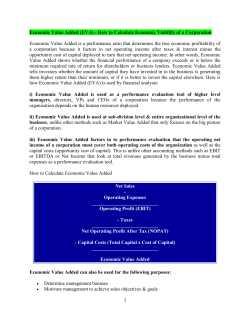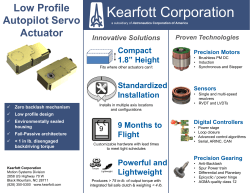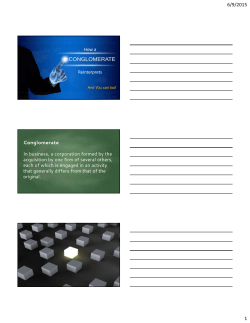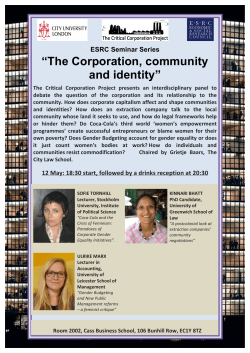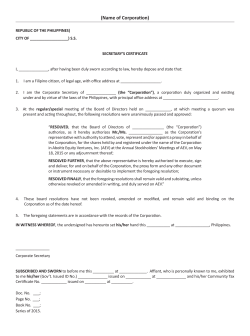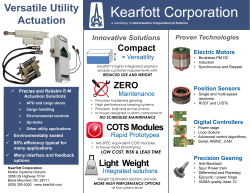
here - Food Industry Environmental Council
June C. Bolstridge GAIA Corporation 9207 Wire Avenue, Silver Spring, MD 20901-3434 301-608-9469 gaiaco@earthlink.net http://jgeglobal.net June C. Bolstridge President of GAIA Corporation in Silver Spring, Maryland. Certified as a Qualified Environmental Professional (QEP). Environmental engineer with more than 30 years of experience working with manufacturing corporations. Provide regulatory & technical updates on U.S. & European topics for corporate EHS vice presidents, directors, & managers. Provide manufacturing corporations with compliance assistance, environmental training, and tailored guidance development on chemical management requirements under: Emergency Planning and Community Right-to-Know Act (EPCRA). Spill Planning, Reporting, & Notification (EPCRA; CERCLA; SPCC) European REACH Legislation. Globally Harmonized System(GHS) for Chemical Classification & Labeling; & European Classification, Labelling, & Packaging (CLP) regulations. Masters Degree in Environmental Engineering (University of Washington) & B.S. in Chemistry & Botany (SUNY College of Environmental Science and Forestry, & Syracuse University). © 2015 June Bolstridge, GAIA Corporation 2 Environmental Developments Affecting Food & Beverage Corporations Recap & Update from 2014: Env. Regulatory Drivers Presentation Chemical lists, bans, & restrictions Natural resource scarcity & disruptions Data availability & information sharing 2015 Emerging Challenges: regulatory, technical, & societal issues… & useful resources & tools to address them. © 2015 June Bolstridge, GAIA Corporation 3 2014 Presentation: Chemical Lists & Bans Pesticides & Endocrine Disruptors EPA Office of Pesticide Programs – Regulations http://www.epa.gov/pesticides/food/viewtols.htm Endangered Species Act – pesticide assessment process – being drafted (per 2013 National Academy of Sciences). Honeybees & pollinators protection plan – draft early 2015 (required by June 2014 Presidential Memo). Updated pesticide worker protection standards (proposed Mar. 2014) – train to reduce exposure & buffer zone on treated fields. Pesticide registrations now require evaluating spray drift & volatilization using March 2014 guidance & models, & evaluations for pollinator protection. Delayed by EPA budget & staff reductions (lowest since 1989). EPA Endocrine Disruptor Screening Program http://www.epa.gov/endo/ First results from Testing & Computational Toxicology Program. In 2015: expect results for 52 Tier 1 chemicals (mostly pesticides) & selection of more Tier 1 candidate chemicals. © 2015 June Bolstridge, GAIA Corporation 4 2014 Presentation: Natural Resources Scarcity Landfill Bans on Food Waste… Expect More Massachusetts landfill ban on commercial food waste of 1 ton/week or more effective on Oct. 1, 2014. June 2014 Guidance for Industry http://www.mass.gov/eea/docs/dep/recycle/laws/orgguid.pdf Sites accepting diverted food waste http://www.mass.gov/ eea/docs/dep/recycle/reduce/06-thru-l/fdcomlst.pdf Connecticut & Vermont; Seattle, San Francisco & Portland – ban landfilling commercial food waste. More landfills reaching capacity & EPA says are 3rd largest source of methane in U.S. (a potent greenhouse gas) http://epa.gov/climatechange/ghgemissions/gases/ch4.html New York City law of Dec. 2013 takes effect July 1, 2015. http://legistar.council.nyc.gov/LegislationDetail.aspx?ID=1482542&GUID=DDD940 82-C0E5-4BF9-976B-BBE0CD858F8F&Options=&Search= Rhode Island’s 2014 law takes effect Jan. 1, 2016 – businesses & institutions generating 2 tons of food scrap/week or more must use composting or anaerobic digestion if facility is in 15 miles & costs < landfill. Exempts public grade schools. http://webserver.rilin.state.ri.us/BillText/BillText14/HouseText14/H7033Aaa.pdf New Jersey – proposed law based on Rhode Island. http://www.billtrak.net/bt216/billtext/S_2/S_2494I1.HTM © 2015 June Bolstridge, GAIA Corporation 5 2014 Presentation: Natural Resources Scarcity Water – Cost & Availability in the U.S.: 6% cost increase in 30 major U.S. cities in 2014, & rose a total of 33% since 2010. http://www.circleofblue.org/waternews/2014/world/pricewater-2014-6-percent-30-major-u-s-cities-33-percent-rise-since-2010/ Bridging Concern and Action: Are US Companies Prepared for Looming Water Challenges? (April 2014) – survey industries’ water effects. http://voxglobal.com/managing-water-risk-study/ GEMI’s Water Sustainability Tool http://www.gemi.org/water/ © 2015 June Bolstridge, GAIA Corporation 6 Emerging Challenge: Waste Management Estimated Volume of Food Waste 30% of all food produced is wasted or goes uneaten (UN’s Food & Agriculture Organization, 2010 report) USDA Food Loss Report: 1/3 is by retailers; 2/3 is by consumers http://www.ers.usda.gov/amber-waves/2014-june/foodloss%e2%80%94questions-about-the-amount-and-causes-stillremain.aspx#.VPZ0yV45CE0 (June 2014) © 2015 June Bolstridge, GAIA Corporation 7 Emerging Challenge: Waste Management Industry Report & Toolkit for Food Waste Food Waste Reduction Alliance Includes 30 manufacturers, retail & foodservice operators, NGOs, & waste mgmt. orgs. Started in 2011 by: Grocery Manufacturers Assoc. Food Marketing Institute. National Restaurant Assoc. November 2014 report, analysis, & infographic on food waste from manufacturing, resale, wholesale, & restaurants; & reduction barriers http://www.foodwastealliance.org/wpcontent/uploads/2014/11/FWRA_BSR_Tier3_FINAL.pdf Best Practices & Emerging Solutions Toolkit (Sept. 2014) http://www.foodwastealliance.org/wp-content/uploads/2014/09/BestPractices-Toolkit-FINAL-5-1-14_rev091714.pdf © 2015 June Bolstridge, GAIA Corporation 8 Emerging Challenge: Waste Management Global Accounting & Reporting Standard Food Loss & Waste Protocol – standard for food loss, food waste, & inedible parts of food, & the ultimate disposition http://www.wri.org/our-work/project/food-loss-waste-protocol Approach of World Resources Institute Greenhouse Gas Protocol – what is defined can be measured & reduced. Expert groups are developing Protocol methods; independent of regulatory programs. WRI, along with FAO, UNEP, World Business Council for Sustainable Development, Consumer Goods Forum, Waste & Resources Action Program, & EU FUSIONS. Expect to publish first version in September 2015. © 2015 June Bolstridge, GAIA Corporation 9 Emerging Challenge: Waste Management Resources for Food Waste Reduction EPA Food Recovery Challenge – 835 participants: grocers; stadiums & venues; universities; cities & counties. Food waste recovery providers http://www.epa.gov/foodrecovery/fd-service.htm#univ Food waste assessment tools http://www.epa.gov/ epawaste/conserve/foodwaste/tools/index.htm Webinars [6 biogas production facilities: March 2015] http://www.epa.gov/epawaste/conserve/smm/foodrecovery/ frc_webnr_archve.htm Mobile App: Webalo SCIM (Supply Chain & Inventory Management) – secure development platform, for manufacturers, retailers & wholesalers to manage inventory, real time on mobile devices (January 29, 2015) https://www.webalo.com/webalo-bell-nursery-pr.php Integrates & shares data with enterprise applications from IBM, Oracle, Microsoft, SAP, Salesforce.com & custom-built apps. Task list contained in the app was developed by Bell Nursery to manage plants at 170 stores & reduced inventory waste by 50%. Users can further customize the app to fit their specific supply chains. © 2015 June Bolstridge, GAIA Corporation 10 Emerging Challenge: Waste Management GHG Emission from Waste Reductions EPA Waste Reduction Model (WARM) calculates GHG emissions – 50 waste types http://epa.gov/epawaste/conserve/tools/warm/index.html Baseline & waste mgmt.(reduction, recycling, combustion, composting, & landfilling) in carbon equivalent, CO2 equivalent, & energy (million BTU). June 2014 added source reduction factors for non-meat food waste types (grains, bread, fruits & veggies, & dairy products) to Excel version http://epa.gov/epawaste/conserve/tools/warm/pdfs/Food_Waste.pdf © 2015 June Bolstridge, GAIA Corporation 11 Emerging Challenge: Waste Management Food Packaging Waste: American Institute for Packaging & Environment (AMERIPEN) Reducing Fresh Food Waste: Role of Packaging http://ameripen.org/wp-content/uploads/Reducing -Fresh-Food-Waste-Final.pdf Product Recovery Knowledge Map (PRKM) https://sites.google.com/site/ameripenprkmwiki/ free on-line data on recovery of packaging material. Waste & Opportunity 2015: Environmental Progress and Challenges in Food, Beverage, & Consumer Goods Packaging – report by As You Sow & NRDC (February 2, 2015) http://www.nrdc.org/business/files/consumer-goods-packaging-report.pdf Ranked packaging practices of 47 fast food, beverage, & consumer product companies for: switch to reusable or less material; recycled content; recyclability; & raising recycling rates. Starbucks aggressively seek recycling for packaging. Wal-Mart reduced packaging in global supply chain by 5%. Estimate $11.4B packaging material wasted/year, including unrecoverable containers (flexible plastic pouch packaging must be landfilled). © 2015 June Bolstridge, GAIA Corporation 12 Emerging Challenge: Wastewater, Stormwater, & Wetlands Wastewater – directly related to landfill & water issues: Liquid organic wastes (e.g., food process wash water) are banned from Massachusetts landfills http://www.mass.gov/eea/docs/dep/recycle/laws/orgguid.pdf World Health Organization: U.S. wastes 13 trillion gallons of water/year by producing food that is wasted. Stormwater Resources: Stormwater Fact Sheet: “Food & Kindred Products Facilities” http://water.epa.gov/polwaste/npdes/stormwater/upload/sector_u_food.pdf Stormwater Best Management Practices http://water.epa.gov/polwaste/npdes/swbmp/index.cfm Summary of States’ Stormwater Requirements http://www.epa.gov/npdes/pubs/sw_state_summary_standards.pdf © 2015 June Bolstridge, GAIA Corporation 13 Emerging Challenge: Wastewater, Stormwater, & Wetlands “Connectivity of Streams & Wetlands to Downstream Waters: A Review & Synthesis of the Scientific Evidence” (EPA/600/R-14/475F) http://cfpub.epa.gov/ncea/cfm/recordisplay.cfm?deid=296414 EPA Office of R&D review of 1,200 publications and summarizes current understanding of connectivity and mechanisms for streams and wetlands to affect the physical, chemical, and biological integrity of downstream waters (released January 15, 2015). Jan. 29, 2015 – “Waters of the U.S.” Proposed Rule – withdrawn by EPA & Army Corps proposed in April 2014 (79 FR 22188) to clarify Clean Water Act authority to regulate smaller water bodies like streams & rivers http://www2.epa.gov/ cleanwaterrule/memorandum-withdrawing-interpretive-rule Expect a new draft rule to redefine “Waters of the U.S.” © 2015 June Bolstridge, GAIA Corporation 14 Emerging Challenge: GHS Implementation U.S. HCS Deadline: June 1, 2015 Workplaces must have revised labels & Safety Data Sheets (SDS) for all hazardous materials under the OSHA Hazard Communication Standard (HCS). OSHA enforcement policy letter of Oct. 31, 2014 https://www.osha.gov/dep/enforcement/hazcom_enforcement-memo.html – enforcement discretion on SDSs & labels, if company: Labels & MSDSs comply with current HCS requirements. Demonstrates due diligence & documents good faith effort to obtain info., including contacting suppliers & to identify alternate suppliers. Has plan to reach HCS compliance in “a reasonable period of time after June 1, 2015.” © 2015 June Bolstridge, GAIA Corporation 15 Emerging Challenge: GHS Implementation Review & Log Vendors’ SDS Evaluate SDS to verify contains 16 specific GHS headings & that information matches the label. Recommend: prepare for frequent & repetitive revisions to SDS by vendors & actively archive old versions of SDSs – to reduce confusion & volume of SDSs. Log revisions & revise material acceptance procedures: Review formulation & composition changes for regulatory effects. Link the SDS to material formulation changes by lot or batch. Recognize revised materials’ hazard info. in reclassifications. Implement new training, safe handling, storage, & PPE. Revise any product labels within 6 months of new info. © 2015 June Bolstridge, GAIA Corporation 16 Emerging Challenge: GHS Implementation 2014 Citations at Food & Beverage Industries Top 5 Citations for Food Manufacturing https://www.osha.gov/ pls/imis/citedstandard.naics?p_naics=311&p_esize=&p_state=FEFederal Top 3 Citations for Beverage Manuf. https://www.osha.gov/ pls/imis/ citedstandard.naics?p_naics=3121&p_esize=&p_state=FEFederal © 2015 June Bolstridge, GAIA Corporation 17 Emerging Challenges: Social Innovation Local Food Sourcing Trends in U.S. Local and Regional Food Systems: A Report to Congress (January 2015) http://www.ers.usda.gov/publications/ap-administrative-publication/ap068.aspx FDA Food Environmental Atlas http://www.ers.usda.gov/dataproducts/food-environment-atlas/go-to-the-atlas.aspx © 2015 June Bolstridge, GAIA Corporation 18 Emerging Challenges: Social Innovation Ingredients – Natural or Added by Industry Lead & cadmium concentrations in chocolates under California Proposition 65 for failure to warn consumers (Feb. 11, 2015) http://www.asyousow.org/our-work/environmental-health/toxic-enforcement/lead-andcadmium-in-food/ As You Sow found 26 of 42 chocolate products above “safe harbor” max. of 0.5 mg/day of lead & 4.1 mg/day of cadmium. Suing: Hershey’s, See’s Candies, Mars, Mondelez, Godiva, Ghirardelli, Lindt, Green & Black’s, Bissingers, Kroger, Whole Foods, Trader Joe’s, Earth Circle Organics, Moonstruck, Theo, Vosges, & Lake Champlain. Azodicarbonamide (or E927) http://www.alternet.org/food/500-otherfoods-besides-subway-sandwich-bread-containing-yoga-mat-chemical Europe and Australia ban use in food; FDA deemed safe in US. Eliminated by Subway in February 2014. Contained in Dunkin, McDonald’s, Burger King, KFC, Starbucks, & Arby’s “…commonly used to increase the elasticity of items such as shoe soles and yoga mats, and was found to be carcinogenic in lab mice.” © 2015 June Bolstridge, GAIA Corporation 19 Emerging Challenges: Social Innovation Natural or Artificial Colors & Flavors Nielson’s 2014 Global Health & Wellness Survey [30,000 online respondents in 60 countries released January 2015] http://www.nielsen.com/content/dam/nielsenglobal/eu/nielseninsights/pdfs/Ni elsen%20Global%20Health%20and%20Wellness%20Report%20%20January%202015.pdf Very Important to Purchase Decision: No artificial colors & flavors Sustainably sourced ingredients Organic ingredients Locally sourced herbs or ingredients U.S. Respondents European Respondents 29% 20% 24% 20% 42% 25% 28% 23% Center for Science in the Public Interest – petitioning U.S. manufacturers http://www.cspinet.org/fooddyes/ Nestle will have all natural colorants by end of 2015; were already replaced in UK in 2012 “due to consumer sentiment”. Hershey – “simple ingredient policy” phased-in & new products. Mars – exploring natural alternatives; sees no risk or concerns. © 2015 June Bolstridge, GAIA Corporation 20 Emerging Challenge: Food Safety & International Markets FDA Food Safety Modernization Act [1st compliance deadlines: late 2016] http://www.fda.gov/Food/GuidanceRegulation/FSMA/default.htm “National Kick-Off Meeting on FSMA Implementation” – April 23-24. Court-ordered deadlines for FDA to issue 7 final FSMA rules remain: Aug. 30, 2015: Preventive Controls for Human Food; & Preventive Controls for Animal Food Oct. 31, 2015: Produce Safety; Foreign Supplier Verification; & Accrediting 3rd Party Auditors March 31, 2016: Sanitary Transportation of Food May 31, 2016: Intentional Adulteration World Health Organization (WHO) World Health Day April 7, 2015 – will be dedicated to food safety http://www.who.int/foodsafety/en/ Threshold of Toxicological Concern (TTC) http://www.who.int/foodsafety/areas_work/chemical-risks/TTC/en/ Establish globally agreed level for chemicals in food. Report due late Spring 2015. Comparison of Global Food Traceability Regulations & Requirements from Global Food Traceability Center (GFTC) http://onlinelibrary.wiley.com/enhanced/doi/10.1111/1541-4337.12101/ (August 2014) – report on 21 countries traceability regulations & database, & required documentation for imported products. © 2015 June Bolstridge, GAIA Corporation 21 Emerging Challenge: Nanomaterials EPA Draft Data Collection Requirements TSCA Section 8(a) Rule for Manufactured or Processed Nanoscale Materials – sent to OMB Oct. 6, 2014 & planned for March 2015, but not yet publicly released http://www.reginfo.gov/public/do/eAgendaViewRule?pubId= 201410&RIN=2070-AJ54 [EPA withdrew 2014 proposed reg.] Require detailed reporting of production volume, methods of manufacture & processing, exposure & release information, & available health & safety data. 2015 Preliminary Clean Water Act Effluent Limitations Guidelines Plan (Sept. 16, 2014; 79 FR 55472) requires any information available on wastewater hazards & discharges associated with manufacture of nanomaterials & use in manufacturing or formulating products, & any other relevant information. Expect final plan in September 2015. © 2015 June Bolstridge, GAIA Corporation 22 Emerging Challenge: Nanomaterials FDA: June 2014 Nanotechnology Guidance FDA "does not make a categorical judgment that nanotechnology is inherently safe or harmful, and will continue to consider the specific characteristics of individual products.” “Industry remains responsible for ensuring that its products meet all applicable legal requirements, including standards for safety”. Guidance to clarify regulations on nanomaterials & encourage manufacturers to consult FDA before marketing products. Nanotechnology approach to FDA regulated products: http://www.fda.gov/ScienceResearch/SpecialTopics/Nanotechnology/default.htm External or internal dimension between 1 to 100 nanometers. Engineered to exhibit physical or chemical properties, or biological effects attributable to its dimension(s), even if these dimensions fall outside the nanoscale range, up to one micrometer (1,000 nm). Draft guidance on food for animals http://www.fda.gov/ScienceResearch/SpecialTopics/Nanotechnology/ucm401782.htm June 2014 FDA non-binding guidance on “Emerging Technologies” discusses nanomaterials & food safety: Guidance for Industry: Assessing Effects of Significant Manufacturing Process Changes, Including Emerging Technologies, on the Safety and Regulatory Status of Food Ingredients & Food Contact Substances http://www.fda.gov/Food/GuidanceRegulation/ GuidanceDocumentsRegulatoryInformation/ucm300661.htm © 2015 June Bolstridge, GAIA Corporation 23 Emerging Challenge: Nanomaterials Other Influence on U.S. Food Industry Slipping Through the Cracks: An Issue Brief on Nanomaterials in Foods – report by As You Sow http://www.asyousow.org/ays_report/slipping-through-the-cracks/ Dunkin Brands will remove titanium dioxide, a whitening agent commonly containing nanomaterials, from all powdered sugar used on Dunkin Donuts. As You Sow withdrew shareholder proposal to require assessment & reduce nano materials risk; received 18.7% support at 2014 annual meeting. EU required listing engineered nanomaterials on food labels in force on 13 December 2014 http://ec.europa.eu/food/food/labellingnutrition/foodlabelling/index_en.htm Ingredients list must identify engineered nanomaterials with the word "nano" in brackets after the ingredient name. 3 year phase-in for new labels, established in 2011. Distribution allowed of stocks already placed on market or labeled. © 2015 June Bolstridge, GAIA Corporation 24 Wrap-Up: Update to 2014 “Regulatory Drivers”. Emerging challenges for 2015… & useful resources & tools] Waste management Water: stormwater, wetlands, & Waters of the U.S. GHS implementation – U.S. OSHA Haz. Com. Standard Social innovation – local sourcing & ingredients Food safety & international markets Nanomaterials More Info: Sustainability Resources Handout – see me during the conference for a copy. © 2015 June Bolstridge, GAIA Corporation 25
© Copyright 2025


